Traditional Japanese Recipes to Bring Japan to Your Kitchen

Have you ever been drawn to the smells and tastes of Japanese food? The first time I tried authentic Japanese dishes, it was amazing. It was like going on a journey to Japan without leaving my home. We can make sushi, miso soup, or delicious ramen right where we are. And it’s not hard at all. I’ll show you how.
Making traditional Japanese food at home is very rewarding. Every recipe has its own story and traditions. You can bring these into your kitchen with some easy steps and ingredients. It doesn’t matter if you’re a pro or just starting to cook. These authentic Japanese recipes will make your meals exciting. Are you ready to add a taste of Japan to your table? Let’s dive in!
Key Takeaways
- Experience the vibrant flavors of authentic Japanese recipes from your home kitchen.
- Homemade traditional Japanese food can be simple and incredibly rewarding.
- Sushi, ramen, and miso soup are staple dishes that bring a slice of Japan to your dining table.
- Japanese cuisine is steeped in history and tradition, offering a unique culinary experience.
- Getting started with Japanese recipes requires just a few key ingredients and techniques.
Introduction to Traditional Japanese Cuisine
Welcome to the delightful world of Traditional Japanese cuisine! Let’s discover what makes Japanese food unique. We’ll explore its simplicity and depth together.
What Defines Japanese Culinary Tradition?
Japanese cuisine values seasonality, ingredient quality, and how it looks. Each dish is a visual feast. It’s about harmony and balance. Pure flavors come together like a dance.
Key Ingredients in Japanese Cooking
Classic Japanese recipes use rice, seafood, and soy. Think umami-rich soy sauce and dashi broth. Daikon radish and shiitake mushrooms can transform a dish.
Regional Variations in Japanese Food
Each region in Japan offers unique tastes. Hokkaido is known for its seafood. Kyoto serves up vegetarian dishes from its Buddhist history.
Explore flavors from Kyushu’s spicy ramen to Tokyo’s kaiseki meals. Start your own food adventure!
Ready to start your journey into Japanese cooking? Put on those aprons and let’s experiment in the kitchen!
Essential Japanese Cooking Techniques
Mastering Japanese recipes with rice and sushi is all about technique. These skills will make your meals much better!
The Art of Rice Cooking
Cooking rice is an art in Japan. You must rinse the rice until the water is clear. Then, let it soak for 30 minutes before cooking.
After cooking, let it steam for 10 minutes. This patience gives it a perfect texture.

Mastering Sushi Rolling
Rolling sushi seems tough, but practice makes perfect. Start with sushi recipes. Spread the rice evenly on the nori.
Add your fillings, then roll tightly with a bamboo mat. Use water to keep rice from sticking to your hands.
Simmering and Steaming Methods
Simmering and steaming are key in Japanese cooking. Simmering blends flavors, like in Nikujaga (meat and potato stew). Steaming keeps food fresh and nutritious.
Whether it’s vegetables, fish, or dumplings, steaming is essential. A good steamer is a must-have for Japanese meals.
Popular Traditional Japanese Dishes
Japanese cuisine is full of standout dishes known worldwide. These meals show the rich tradition of Japanese cooking. They are perfect for anyone looking to try new recipes, from expert chefs to home cooks.
Sushi: A Delicacy of Japan
Sushi is a must-try in Japanese cuisine. It looks beautiful and tastes delicate. It mixes vinegared rice with fresh fish and veggies. Making sushi can be fun and rewarding. You can start with simple rolls and nigiri, then try more complex styles.
Ramen: Comfort in a Bowl
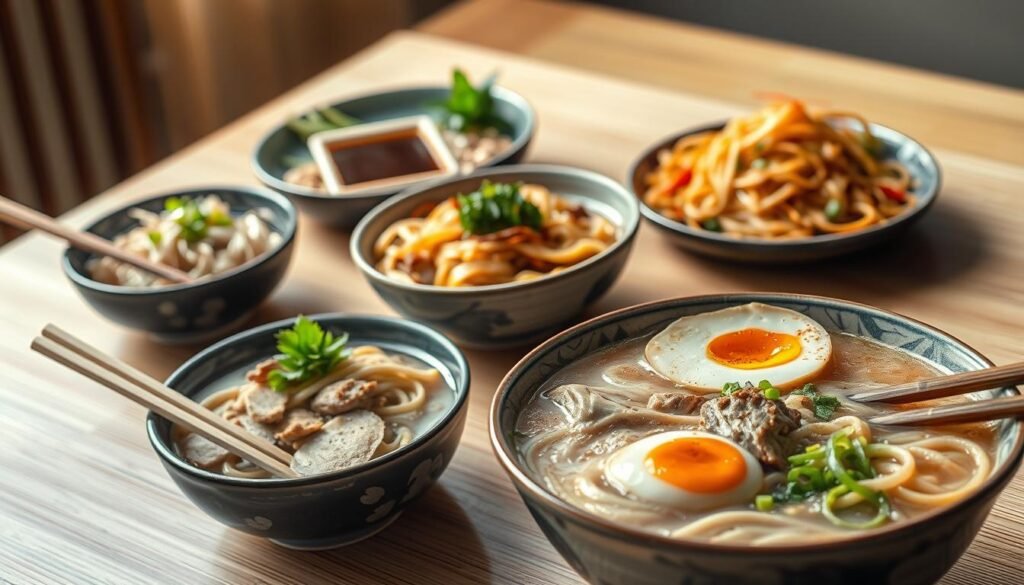
Ramen is a classic Japanese noodle dish loved by many. It’s wheat noodles in a tasty broth with toppings like pork, nori, and egg. Japan offers various ramen flavors, from rich pork-based to light miso. A great bowl of ramen has well-balanced flavors and top-notch ingredients.
Tempura: The Perfect Fried Dish
Tempura is key in Japanese cuisine. It’s frying seafood and veggies until they’re crispy outside but still flavorful inside. Great tempura needs very cold batter and the right frying temperature. Enjoy it with dipping sauce for a crunchy treat.
Trying these dishes gives you a glimpse into Japan’s culinary world. Cook these classic recipes to bring some Japanese flair to your kitchen!
The Importance of Umami in Japanese Recipes
Discovering umami is like finding a new flavor dimension. It brings depth to every dish. In Japan, umami makes simple recipes rich and full. It helps create perfect harmony in your meals. Let’s see how this special taste does its magic!
Understanding Umami Flavors
Umami is known as the “fifth taste.” It stands with sweet, sour, salty, and bitter. It’s a savory feel found in amino acid-rich foods, like glutamate. The first time I tried miso soup, its soulful taste captivated me. This is umami at work. In Kyoto, this taste is skillfully used in their famous dishes.
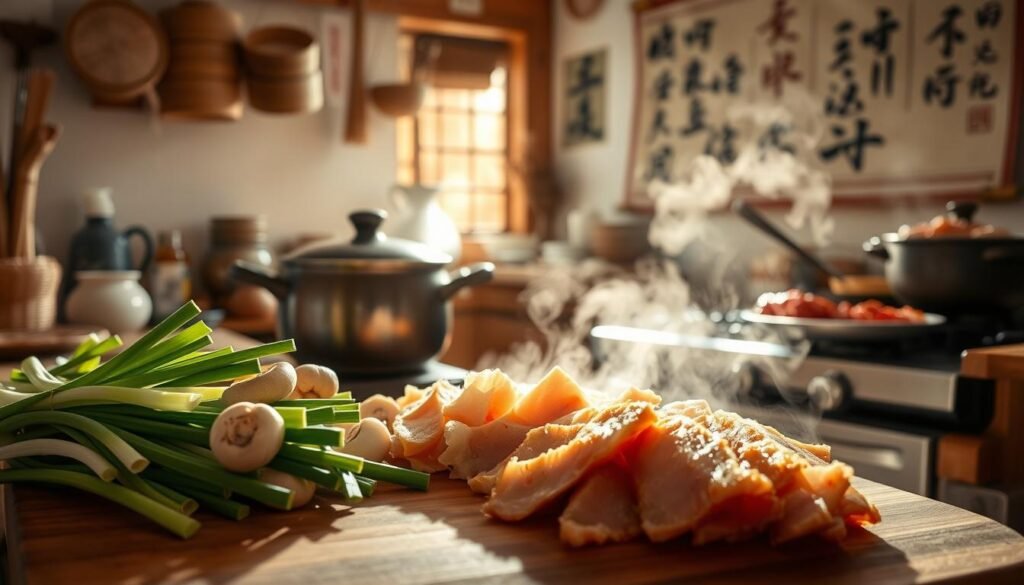
Ingredients That Enhance Umami
It’s easy to add umami to your cooking. Use miso, soy sauce, shiitake mushrooms, kombu, and bonito flakes. These ingredients have natural umami boosters. They enrich flavors without needing much salt or fat. It’s a simple trick for tasty meals.
How Umami Influences Japanese Cooking
Umami makes all flavors in a dish stand out. It can turn simple meals into something special. By using umami well, anyone can elevate their cooking. Kyoto’s dishes often use this secret to taste incredible. You’ll love using umami-rich ingredients in your food!
| Ingredient | Umami Component | Common Usage |
|---|---|---|
| Miso | Glutamate | Soups, sauces |
| Shiitake Mushrooms | Guanylate | Stir-fries, soups |
| Kombu | Glutamate | Dashi broth, soups |
| Soy Sauce | Glutamate | Marinades, dipping sauces |
| Bonito Flakes | Inosinate | Dashi broth, toppings |
Seasonal Japanese Ingredients
Enjoying Japanese seasonal eating is amazing! Spring’s bamboo shoots to autumn’s mushrooms show nature’s cycle. Seasonal ingredients make dishes fresh and tasty!
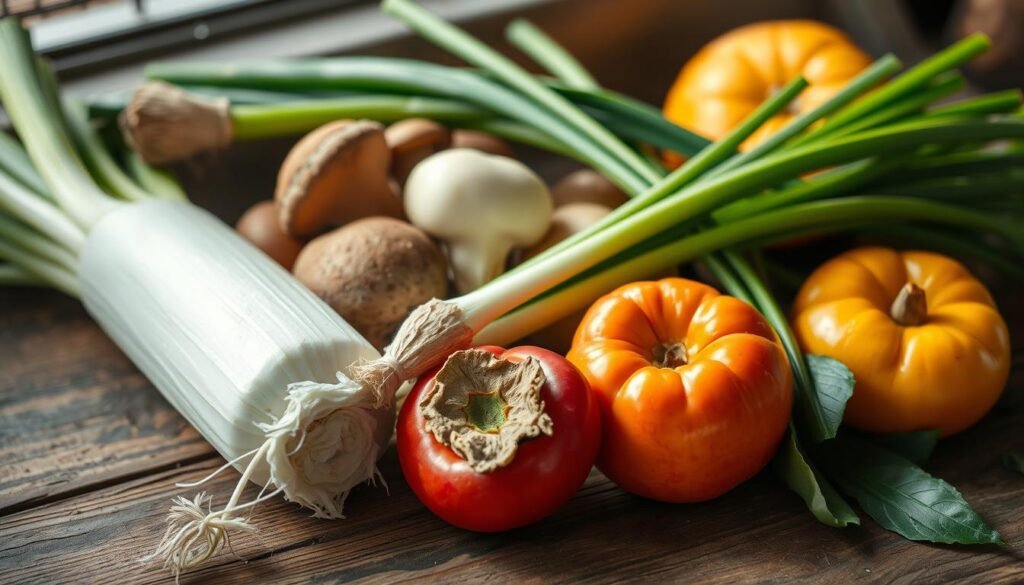
Spring Ingredients: Bamboo Shoots and Sansai
Spring brings bamboo shoots and sansai, or mountain veggies. Imagine the crunch and sweet taste of bamboo shoots. They’re great in traditional Japanese chicken dishes, adding a perfect balance.
The unique, slightly bitter sansai adds an earthy flavor to meals. It’s a taste of spring!
Summer Delicacies: Grilled Fish and Cold Noodles
Summer means light food in Japan. Grilled fish like mackerel and sardines shine. They’re often in Japanese food with fish.
Combined with cold noodles like soba or udon, it’s a perfect summer meal. It keeps you cool and satisfied.
Autumn Harvest: Chestnuts and Mushrooms
Autumn offers rich, flavorful seasonal ingredients. Chestnuts sweeten dishes, mushrooms add depth. Think of a warm mushroom soup on a cool evening – that’s autumn in Japan.
| Season | Ingredients | Popular Dishes |
|---|---|---|
| Spring | Bamboo Shoots, Sansai | Seasonal Tempura, Chicken Stew |
| Summer | Grilled Fish, Cold Noodles | Grilled Mackerel, Cold Soba |
| Autumn | Chestnuts, Mushrooms | Mushroom Soup, Steamed Chestnuts |
Traditional Japanese Soups and Broths
Diving into traditional Japanese soups and broths brings you closer to Japan’s culture. These dishes are central to many meals in Japan, loved for their straightforward yet rich tastes. Miso soup and Tonjiru are just some examples that show the variety and joy these meals offer.
Miso Soup: A Staple in Japanese Households
Miso soup stands out in Japan. It’s both simple and deeply fulfilling. Imagine starting your morning with a hot bowl of it. The mix of miso paste, dashi, tofu, and seaweed balances tasty flavor and health. Miso soup fits perfectly with a traditional breakfast or as a starter for dinner, always satisfying.
Tonjiru: A Heartwarming Pork Miso Soup
If you’re ready for something hearty, try Tonjiru. Think of it as the hearty friend of soups! Filled with pork belly, veggies, and tofu, it’s full of taste and texture. It’s great for cold days, offering warmth and nourishment. Tonjiru makes family meals or traditional appetizers special.

Dashi: The Foundation of Japanese Cooking
Talking about Japanese soups means talking about Dashi. This broth is key to many Japanese dishes. It’s made from kombu (kelp) and katsuobushi (dried bonito flakes). Dashi is the base for soups, stews, and some stir-fries. Learning Dashi takes your cooking to new levels, with real Japanese taste.
| Ingredient | Role in Dashi |
|---|---|
| Kombu (Kelp) | Provides a rich umami base |
| Katsuobushi (Dried Bonito) | Adds depth and smokiness |
| Water | Base to bring out flavors |
Understanding Dashi’s vital elements prepares you for making fantastic Japanese food. The world of Traditional Japanese soups is vast and exciting. You’re encouraged to dive in and try making these flavors at home!
Exploring Japanese Pickles and Fermentation
When we dive into Japanese food traditions, we find something really cool. Pickles and fermentation aren’t just about keeping food. They change it and make it better! Let’s go on a journey through this amazing process.
Tsukemono: Japanese Pickles Explained
First off, let’s talk Tsukemono. These aren’t your average pickles. They’re a form of art! From bright takuan (pickled daikon radish) to sour umeboshi (pickled plums), Tsukemono offers a fun crunch and flavor to meals. They’re a great pick for adding Japanese flair to your cooking.
The Fermentation Process in Japanese Cooking
Ever wonder what makes fermented foods taste so unique? It’s the fermentation magic! In Japan, this method does more than keep food. It ups the umami taste and health benefits. Things like miso paste, soy sauce, and sake all come from this cool tradition. Learning about pickles and fermentation shows us their role in a healthy life.
Serving Suggestions for Tsukemono
So, how should we serve Tsukemono? They’re super flexible. Try them with rice or with dishes like soba noodles or tofu. They add a fresh zing and help even out heavy tastes.
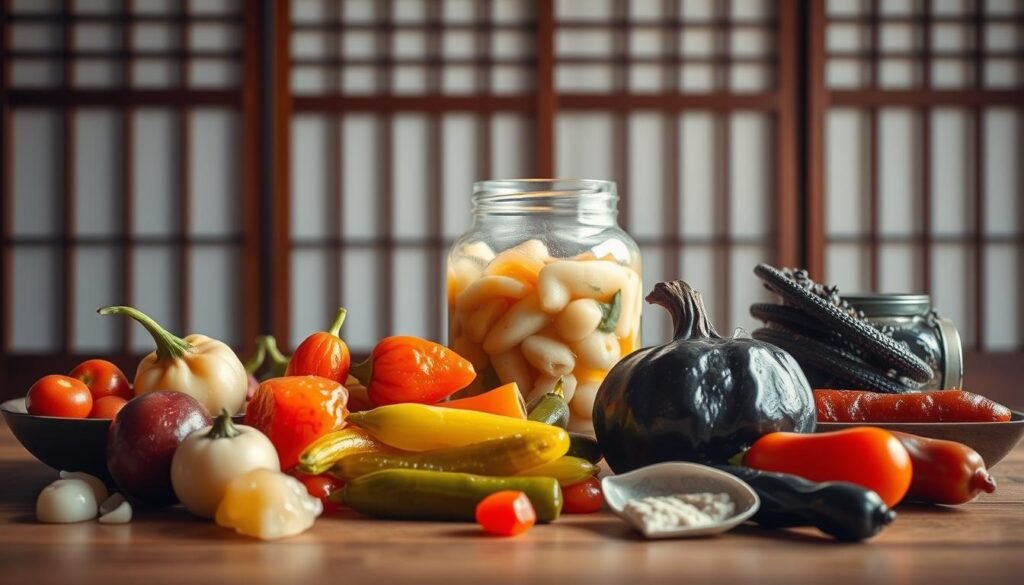
Get into the world of Japanese pickles and fermentation. It mixes old ways with health in a fun twist. Enjoy exploring!
Japanese Desserts and Sweets
Explore the wonderful world of Japanese desserts! These treats are tasty and pretty to look at. They are perfect for satisfying a craving or showing off to friends. There’s a sweet treat for everyone.
Mochi: A Chewy Delight
Ever tasted Mochi? It’s a soft, sticky rice cake with different yummy fillings. I find it amazing because you can choose flavors like red bean or fruit. It’s key in many Japanese rice dishes. Why not try it out?
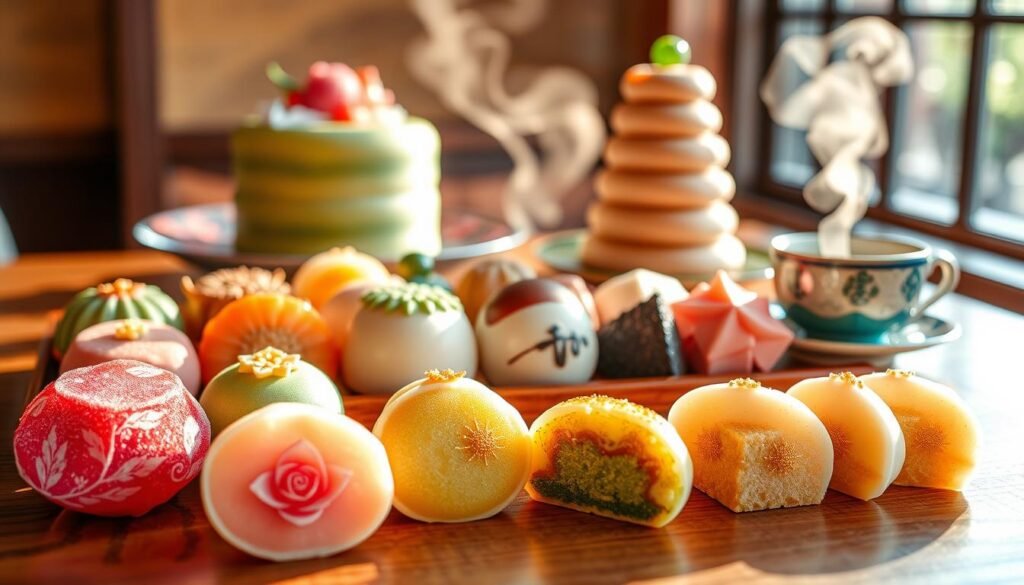
Matcha Desserts: Embracing Green Tea Flavor
Love green tea? Then Matcha desserts are for you. There’s Matcha ice cream and cakes. The unique flavor of Matcha is not just tasty but healthy too. These treats perfectly mix taste and tradition.
Daifuku: Sweet Rice Balls with Fillings
Daifuku offers a soft rice ball with yummy fillings. Try it with red bean paste, strawberries, or ice cream. It’s a wonderful end to any meal, especially with Japanese rice bowls. The soft outside and tasty filling will keep you coming back!
| Traditional Japanese Dessert | Main Ingredients | Flavor Profile |
|---|---|---|
| Mochi | Glutinous Rice, Various Fillings | Chewy, Sweet or Savory Fillings |
| Matcha Desserts | Matcha Powder, Sugar, Dairy | Earthy, Sweet, Slightly Bitter |
| Daifuku | Sweet Rice, Red Bean Paste | Soft, Sweet, Flavorful Fillings |
Bringing Traditional Japanese Recipes into Your Home
Want to make your kitchen feel like Japan? You can do it! I’ll show you how to get everything you need. This includes where to find real ingredients and the kitchen tools you should have. We’ll also cover how to plan your meals to make traditional Japanese food any day.
Tips for Sourcing Authentic Ingredients
Let’s start with what you’ll need to cook. Finding the right ingredients is very important. You can find things like miso paste, sake, and nori at local Asian markets. No store close by? Try online at Mitsuwa Marketplace or Asian Food Grocer for home delivery. This way, your food will taste just like it’s supposed to.
Tools and Equipment for Kitchen Success
Now, let’s talk about your kitchen. Having the right tools can make everything easier. You’ll need a good knife, like a Japanese santoku, for sure. Also, think about getting a rice cooker and a bamboo sushi mat. These items help a lot with making vegetable dishes and sushi. It’s a good investment for your kitchen!
Meal Planning with Traditional Japanese Recipes
Finally, we’ll discuss planning your meals. Adding Japanese recipes to your meals is fun and tasty. Begin with something easy, like miso soup or a Japanese breakfast. Later, you can try making ramen or tempura. Use seasonal ingredients to keep things new and exciting. With some planning, you can enjoy amazing Japanese meals at home!